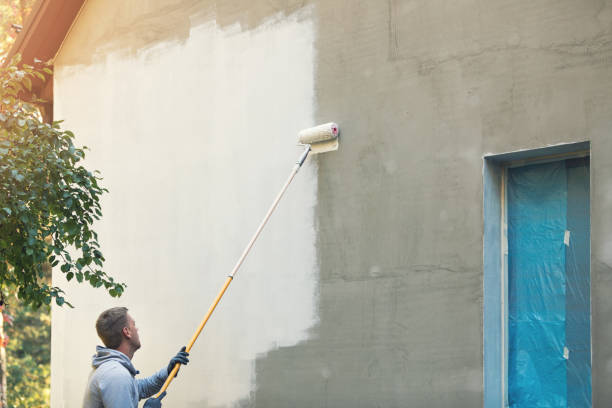Whether you’re looking to refresh your home’s appearance, protect it from the elements, or boost its market value, exterior painting can bring numerous benefits. An expertly executed paint job doesn’t just make a home look attractive; it also serves as a protective shield, ensuring durability against weather, pests, and wear. This guide covers the essentials of exterior painting, from selecting the right materials to finding skilled painters, ensuring a stunning, long-lasting finish.
Why Exterior Painting Matters
Exterior painting isn’t only about aesthetics; it protects the structure from damage caused by the elements. A high-quality exterior paint job resists moisture, sunlight, and temperature fluctuations, helping to keep your home in prime condition.
Choosing the Right Colors for Your Home
The color you choose plays a major role in setting the tone for your home’s exterior. Whether you want a classic look or a bold statement, the right colors can elevate your home’s curb appeal. Consider factors such as neighborhood trends, your home’s architectural style, and the existing landscape. Testing a few samples before committing to a color can also ensure a look you’ll love for years to come.
Preparing for Exterior Painting
Preparation is key for a successful paint job. Properly cleaning, sanding, and priming the surfaces ensures that the paint adheres correctly and lasts longer. Preparation steps often include:
- Power washing: Removes dirt, grime, and mildew that may affect paint adhesion.
- Sanding and scraping: Smoothens rough areas and removes loose paint.
- Caulking and sealing: Prevents water from seeping into cracks, which can cause peeling.
- Priming: Creates a uniform surface for paint application.
Selecting the Right Type of Paint
When choosing exterior paint, durability and weather resistance are essential. Here are the main types of exterior paints to consider:
- Acrylic Paint: Known for its durability and resistance to fading, acrylic paint is suitable for most climates.
- Latex Paint: Easy to clean and quick to dry, latex is a popular option for residential exteriors.
- Oil-Based Paint: Ideal for areas with high exposure to elements, oil-based paint is highly durable but requires more time to dry.
Essential Tools and Materials for Exterior Painting
Using the right tools ensures efficiency and a smooth, professional finish. Essential tools for exterior painting include:
- Rollers and brushes: High-quality brushes are crucial for even coverage, while rollers are effective on large surfaces.
- Extension poles and ladders: Necessary for reaching higher areas safely.
- Drop cloths and painter’s tape: Protects surrounding areas and allows for clean, sharp lines.
- Sprayers: Helpful for larger surfaces, though they require skill to avoid overspray.
The Painting Process: Step-by-Step
An organized painting process makes the job manageable and ensures lasting results:
- Start from the top down: Begin with eaves and upper walls, then work downward. This prevents drips from landing on freshly painted areas.
- Paint in the shade: Avoid direct sunlight, which can cause paint to dry too quickly and lead to an uneven finish.
- Follow the weather forecast: Plan around rain or extreme temperatures, as they can affect drying and adhesion.
- Apply two coats: Multiple coats provide durability and better color vibrancy.
Common Mistakes to Avoid
While DIY painting can be rewarding, common mistakes can lead to poor results. Here’s what to avoid:
- Skipping prep work: Neglecting surface prep can result in peeling and uneven paint.
- Using low-quality paint: Cheaper paints may save money initially but often require frequent touch-ups.
- Painting in extreme weather: Too hot or cold temperatures can cause cracking and uneven drying.
Benefits of Hiring Professional Painters
While DIY best exterior painting can be tempting, hiring professionals often ensures a better outcome. Skilled painters bring experience, efficiency, and the right equipment. They also have insights into color selection and application techniques, ensuring a seamless, long-lasting finish.
Maintenance Tips for a Long-Lasting Finish
Regular maintenance keeps your exterior paint looking fresh and durable:
- Inspect annually: Check for signs of chipping, cracking, or mildew growth.
- Clean surfaces periodically: Remove dirt and grime with gentle washing.
- Touch up as needed: Address minor chips and peels promptly to prevent larger issues.
FAQs
Q1: How often should I repaint my home’s exterior?
The frequency of repainting depends on your paint type, climate, and materials. Generally, homes need a fresh coat every 5-10 years.
Q2: Can I paint my exterior in cold weather?
For optimal results, paint in mild temperatures between 50°F and 85°F. Cold weather can hinder drying and adhesion.
Q3: How long does an exterior paint job take?
Depending on the size of the house and preparation needed, it can take anywhere from a few days to a week.
Q4: What’s the best season for exterior painting?
Late spring through early fall is ideal, as mild, dry weather promotes better paint adhesion.
Q5: Do I need a primer for exterior painting?
Primer is essential on unpainted surfaces and areas with old, damaged paint. It improves adhesion and provides a smooth base for paint.
